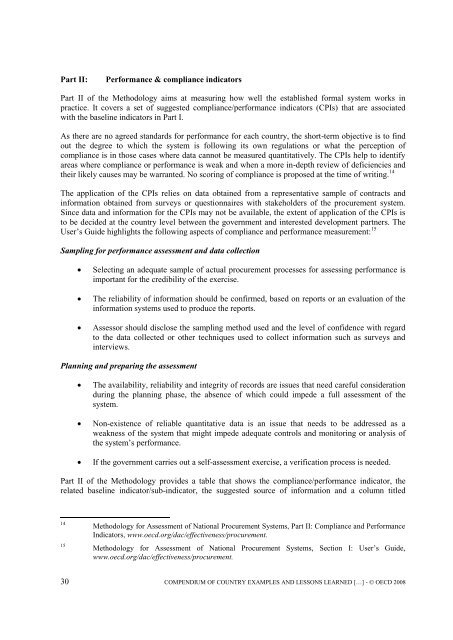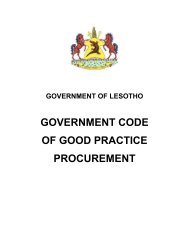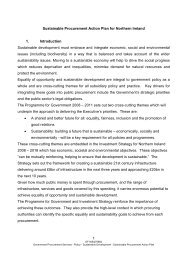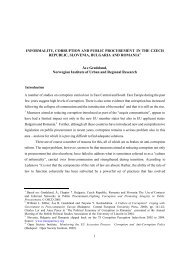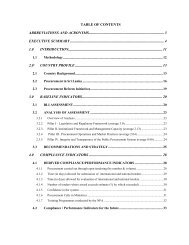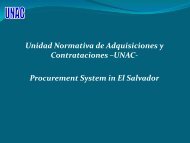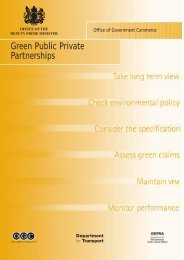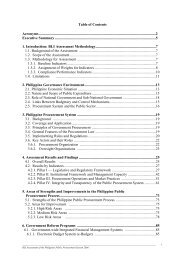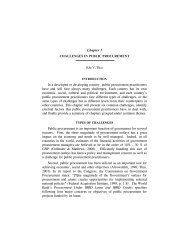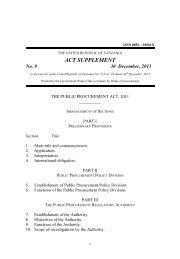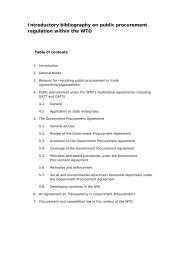Compendium of Country Examples and Lessons Learned from ...
Compendium of Country Examples and Lessons Learned from ...
Compendium of Country Examples and Lessons Learned from ...
You also want an ePaper? Increase the reach of your titles
YUMPU automatically turns print PDFs into web optimized ePapers that Google loves.
Part II:Performance & compliance indicatorsPart II <strong>of</strong> the Methodology aims at measuring how well the established formal system works inpractice. It covers a set <strong>of</strong> suggested compliance/performance indicators (CPIs) that are associatedwith the baseline indicators in Part I.As there are no agreed st<strong>and</strong>ards for performance for each country, the short-term objective is to findout the degree to which the system is following its own regulations or what the perception <strong>of</strong>compliance is in those cases where data cannot be measured quantitatively. The CPIs help to identifyareas where compliance or performance is weak <strong>and</strong> when a more in-depth review <strong>of</strong> deficiencies <strong>and</strong>their likely causes may be warranted. No scoring <strong>of</strong> compliance is proposed at the time <strong>of</strong> writing. 14The application <strong>of</strong> the CPIs relies on data obtained <strong>from</strong> a representative sample <strong>of</strong> contracts <strong>and</strong>information obtained <strong>from</strong> surveys or questionnaires with stakeholders <strong>of</strong> the procurement system.Since data <strong>and</strong> information for the CPIs may not be available, the extent <strong>of</strong> application <strong>of</strong> the CPIs isto be decided at the country level between the government <strong>and</strong> interested development partners. TheUser‟s Guide highlights the following aspects <strong>of</strong> compliance <strong>and</strong> performance measurement: 15Sampling for performance assessment <strong>and</strong> data collectionSelecting an adequate sample <strong>of</strong> actual procurement processes for assessing performance isimportant for the credibility <strong>of</strong> the exercise.The reliability <strong>of</strong> information should be confirmed, based on reports or an evaluation <strong>of</strong> theinformation systems used to produce the reports.Assessor should disclose the sampling method used <strong>and</strong> the level <strong>of</strong> confidence with regardto the data collected or other techniques used to collect information such as surveys <strong>and</strong>interviews.Planning <strong>and</strong> preparing the assessmentThe availability, reliability <strong>and</strong> integrity <strong>of</strong> records are issues that need careful considerationduring the planning phase, the absence <strong>of</strong> which could impede a full assessment <strong>of</strong> thesystem.Non-existence <strong>of</strong> reliable quantitative data is an issue that needs to be addressed as aweakness <strong>of</strong> the system that might impede adequate controls <strong>and</strong> monitoring or analysis <strong>of</strong>the system‟s performance.If the government carries out a self-assessment exercise, a verification process is needed.Part II <strong>of</strong> the Methodology provides a table that shows the compliance/performance indicator, therelated baseline indicator/sub-indicator, the suggested source <strong>of</strong> information <strong>and</strong> a column titled1415Methodology for Assessment <strong>of</strong> National Procurement Systems, Part II: Compliance <strong>and</strong> PerformanceIndicators, www.oecd.org/dac/effectiveness/procurement.Methodology for Assessment <strong>of</strong> National Procurement Systems, Section I: User‟s Guide,www.oecd.org/dac/effectiveness/procurement.30 COMPENDIUM OF COUNTRY EXAMPLES AND LESSONS LEARNED […] - OECD 2008


